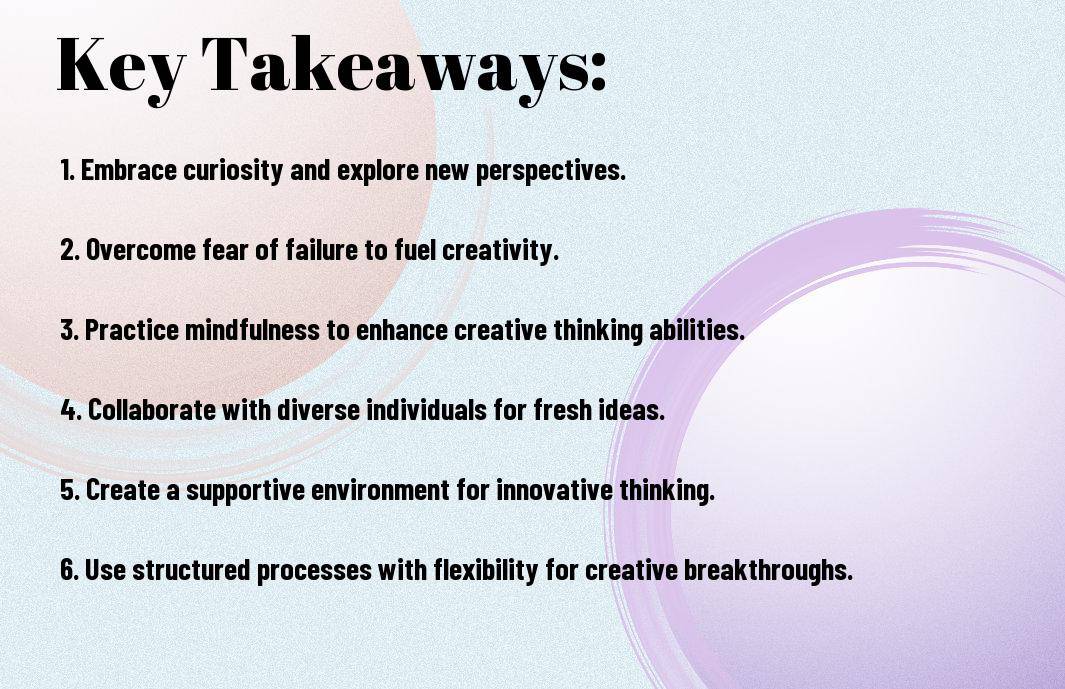Over the years, creativity has been recognized as a crucial skill for innovators looking to stay ahead in today’s fast-paced world. However, many struggle with unlocking their creative potential. This blog post will provide a step-by-step success formula for innovators to enhance their creative abilities and bring their ideas to life. By following these proven strategies, you can tap into your creative genius and drive innovation in your work and life.

Key Takeaways:
- The importance of mindset: Cultivating a growth mindset can unlock creativity and innovation.
- Structured process: Following a step-by-step formula can help in channeling creativity effectively.
- Embracing failure: Failure is a part of the creative process and can lead to valuable insights and breakthroughs.
- Collaboration: Working with a diverse team can bring in fresh perspectives and ideas.
- Continuous learning: Staying curious and open to new knowledge can fuel creativity.
- Experimentation: Trying out new ideas and approaches can lead to innovative solutions.
- Celebrating successes: Recognizing and rewarding creative achievements can motivate further innovation.

Laying the Foundations for Creativity
One of the critical elements in unlocking creativity is laying a strong foundation that nurtures and supports innovative thinking. By setting the stage for creativity, individuals can harness their potential to generate unique ideas, solve complex problems, and make meaningful contributions to their fields. This chapter explores the key steps in establishing these foundations to cultivate a creative mindset and environment.
Cultivating the Right Mindset
Cultivating the right mindset is necessary for unlocking creativity. This involves adopting a growth mindset that embraces challenges, persists in the face of setbacks, and sees failure as a learning opportunity. By fostering a mindset that is open to new possibilities and approaches, individuals can expand their creative thinking and explore innovative solutions. Techniques such as mindfulness practices, journaling, and seeking diverse perspectives can help cultivate a mindset that is conducive to creativity.
Establishing a Creative Environment
The establishment of a creative environment is crucial for nurturing innovation and fostering creativity. Surrounding oneself with inspiration, whether through art, nature, or stimulating conversations, can spark new ideas and fuel creative thinking. Designing physical spaces that encourage collaboration, experimentation, and out-of-the-box thinking can also significantly impact creative outcomes. By creating a space that is conducive to creativity, individuals can enhance their ability to think creatively and generate novel solutions.
Understanding the importance of establishing a creative environment cannot be overstated. A space that is clutter-free, well-lit, and infused with elements that inspire can greatly influence one’s creative output. By curating a space that reflects one’s passions and interests, individuals can create an environment that stimulates their creativity and encourages innovative thinking. Investing time and effort into designing a creative space can yield significant benefits in terms of productivity, motivation, and overall well-being.

Understanding the Creative Process
Not everyone understands the creative process, but it is vital for anyone looking to unlock their creativity and innovate successfully. Creativity is not a mysterious gift that some people possess and others don’t. It is a skill that can be cultivated and honed through practice and understanding.
The Four Stages of Creativity
Understanding the four stages of creativity can help demystify the process and make it more accessible: preparation, incubation, illumination, and verification. In the preparation stage, you gather information and immerse yourself in the problem or idea you are working on. During incubation, your mind subconsciously processes this information. Illumination is when the ‘aha’ moment happens, and a creative idea surfaces. Finally, verification is where you test and refine your idea to bring it to fruition.
Common Misconceptions About Creativity
Misconceptions about creativity can hold people back from embracing their creative potential. Many believe that you have to be born creative or that creativity is only for artists or designers. Others think that creativity is a solo endeavor or that it requires a muse or divine inspiration. These misconceptions can limit individuals from exploring their innovative capabilities to the fullest.
Creativity is not exclusive to a select few; it is a skill that can be developed and nurtured through practice and persistence. By understanding the creative process and debunking common misconceptions, you can unleash your creativity and tap into your full innovative potential.
The Role of Research in Innovation
After The Success Formula: Learning, Adaptability, and Creativity, it is vital to underscore the pivotal role that research plays in driving innovation. Research serves as the foundational building block for creativity and innovation, providing the necessary insights and knowledge to spark new ideas and solutions. By delving into various sources of information, innovators can broaden their perspectives, identify gaps in the market, and uncover emerging trends that can be leveraged to create groundbreaking innovations.
Gathering and Organizing Information
Gathering and organizing information is a critical aspect of the research process. This step involves scouring a wide range of sources such as academic journals, industry reports, competitor analyses, and consumer trends to gather relevant data. Organizing this information in a systematic manner helps innovators draw connections, identify patterns, and extract valuable insights that can fuel the creative process.
Techniques for Effective Research
To conduct effective research, innovators can employ various techniques such as qualitative and quantitative analysis, trend forecasting, benchmarking, and brainstorming sessions. These techniques enable innovators to dive deep into the subject matter, validate their assumptions, and generate innovative ideas based on solid data and insights. It is crucial to adopt a structured approach to research, leveraging both traditional and cutting-edge methods to explore new possibilities and push the boundaries of creativity.
It is important to emphasize the significance of continuous learning and adaptation throughout the research process. Innovators must remain open-minded, curious, and agile, constantly refining their research methodologies and exploring unconventional sources of information to uncover hidden opportunities. By honing their research skills and embracing a growth mindset, innovators can unlock new pathways to innovation and drive sustainable success in a rapidly evolving marketplace.
Idea Generation and Divergent Thinking
Once again, the key to unlocking creativity lies in idea generation and divergent thinking. This process involves exploring a wide range of possibilities and generating as many ideas as possible without judgment or restriction. Creativity thrives when we actively seek new perspectives, challenge assumptions, and think outside the box.
Brainstorming Methods for Innovators
For innovators looking to spark creativity, brainstorming remains a valuable technique. Whether it’s traditional brainstorming sessions with a group or solo brainstorming exercises, the goal is to generate a multitude of ideas without censorship. Mind mapping, Provocation, and Assumption Reversal are just a few effective brainstorming methods that can help innovators break free from conventional thinking and explore unique solutions.
Encouraging Originality and Broad Perspectives
With the fast-paced nature of today’s world, encouraging originality and broad perspectives is imperative for fostering creativity. By exposing yourself to diverse experiences, cultures, and viewpoints, you can expand your mental horizon and approach problem-solving with fresh insights. Embracing diversity and inclusion in your creative process can lead to innovative breakthroughs that cater to a broader audience.
Understanding the importance of originality and broad perspectives not only enhances the quality of your ideas but also sets you apart as a creative thinker. By actively seeking out new experiences, collaborating with individuals from different backgrounds, and challenging your own assumptions, you can cultivate a dynamic environment where creativity flourishes.
Developing and Refining Ideas
Despite the misconception that creativity is an elusive trait possessed only by a select few, the truth is that anyone can be creative with the right mindset and approach. One necessary aspect of unlocking your creativity is developing and refining your ideas to bring them to life in a meaningful way.
Techniques for Convergent Thinking
Techniques for convergent thinking play a crucial role in the creative process as they help you narrow down and focus on the most promising ideas. Some effective techniques include brainstorming, mind mapping, SWOT analysis, and the SCAMPER method. Brainstorming allows for the generation of diverse ideas, while mind mapping helps to visually organize thoughts and connections. SWOT analysis helps evaluate the strengths, weaknesses, opportunities, and threats of each idea, enabling you to make informed decisions. The SCAMPER method prompts you to Substitute, Combine, Adapt, Modify, Put to another use, Eliminate, or Reverse to transform and improve ideas.
From Concept to Prototype
One of the most exciting stages in the creative process is taking your concept and turning it into a tangible prototype. This step involves creating a preliminary version of your idea to test its feasibility and gather feedback for further refinement.
This stage is crucial as it allows you to visualize your idea in a concrete form, identify potential flaws or areas for improvement, and make adjustments before investing significant time and resources. By creating prototypes, you can gain valuable insights, iterate quickly, and ultimately increase the chances of success for your innovation.
Overcoming Creative Blocks and Barriers
To unlock creativity and foster innovation, it is vital to address and overcome creative blocks and barriers. These obstacles can hinder the creative process and impede the flow of new ideas. By recognizing and tackling these challenges head-on, innovators can unleash their full creative potential.
Identifying and Eliminating Obstacles
For many innovators, the first step in overcoming creative blocks is to identify the root cause of the problem. This may involve self-reflection, seeking feedback from others, or simply taking a step back to assess the situation objectively. Common barriers to creativity include fear of failure, perfectionism, lack of inspiration, and limited thinking. By pinpointing these obstacles, innovators can develop effective strategies to eliminate them and pave the way for fresh ideas to emerge.
Strategies for Maintaining Momentum
On the journey to unlocking creativity, maintaining momentum is crucial to sustaining a flow of innovation. One effective strategy is to establish a routine that includes dedicated time for creative pursuits. This consistency helps to keep the creative juices flowing and prevents stagnation. Additionally, setting small, achievable goals can provide a sense of accomplishment and motivate innovators to continue pushing boundaries. Engaging in brainstorming sessions with a diverse group of individuals can also spark new ideas and perspectives, fueling the creative process.
For instance, participating in workshops or attending conferences can expose innovators to new trends and technologies, inspiring them to think outside the box and explore unconventional solutions. By actively seeking out opportunities to engage with other innovators and share ideas, individuals can cultivate a supportive network that fosters creativity and innovation.

Testing and Implementing Creative Solutions
For successful innovators, testing and implementing creative solutions is a critical phase in the innovation process. It is crucial to evaluate ideas thoroughly to ensure they are viable and valuable. If you want to dive deeper into the topic, you can check out Amazon.com: Unlocking Creativity and Innovation: step by step guide to unleash your creativity potential and transform innovative ideas into breakthrough solutions for more insights.
Methods for Evaluating Ideas
Methods for evaluating ideas are crucial to determining which creative solutions are worth pursuing. Some common methods include feasibility studies, market research, prototype testing, and feedback gathering. . It’s important to consider various factors such as market demand, competition, resources required, and potential risks before moving forward with an idea. Do not forget, not all ideas will be successful, so it’s crucial to test and refine them before fully investing in implementation.
Steps to Bring Innovations to Market
Testing your innovations before bringing them to market is crucial for their success. This phase involves conducting pilot tests, collecting user feedback, and iterating based on the results. It’s crucial to fine-tune your product or service based on real-world testing to ensure it meets the needs of your target audience. Plus, developing a solid marketing and launch strategy is key to gaining traction and creating a buzz around your innovative solution. By carefully following these steps, you can increase the likelihood of a successful market launch and create a lasting impact with your creative ideas.
Sustaining Innovation Over Time
Now, to sustain innovation over time, it is necessary to cultivate a culture that embraces creativity and encourages continual learning and improvement. For a deeper examine this topic, you can check out The Innovation Mindset, a book that provides valuable insights into fostering an innovative environment within an organization.
Building and Leading a Culture of Creativity
An organization’s culture plays a crucial role in nurturing creativity and driving innovation. It is necessary for leaders to set the tone by promoting open communication, risk-taking, and celebrating both successes and failures. By fostering a culture that values experimentation and embraces new ideas, organizations can empower their teams to think outside the box and come up with groundbreaking innovations.
Continual Learning and Improvement
On the journey of sustaining innovation, continual learning and improvement are key pillars that drive long-term success. By encouraging a growth mindset and investing in employee development, organizations can equip their teams with the skills and knowledge needed to stay ahead in a rapidly changing landscape. This involves providing opportunities for training, knowledge sharing, and fostering a culture that values innovation as a core competency.
For instance, establishing regular feedback loops and conducting post-mortem analyses after project completion can help identify areas for improvement and facilitate continuous growth. By embracing a culture of openness and adaptability, organizations can enhance their capacity for innovation and stay competitive in the market.
Summing up
So, “Unlocking Creativity – A Step-by-Step Success Formula for Innovators” provides a comprehensive guide for individuals seeking to enhance their creative abilities and become more innovative in their approach. By following the step-by-step formula outlined in the book, readers can unlock their creative potential and harness it to generate groundbreaking ideas and solutions.
With practical techniques, insightful tips, and real-life examples, this book equips innovators with the tools they need to overcome creative blocks, tap into their creative energy, and unleash their full potential. Whether you are a seasoned entrepreneur, a budding artist, or anyone looking to enhance their creativity, “Unlocking Creativity” offers invaluable insights and strategies to help you achieve your innovative goals.
FAQ
Q: What is the key focus of ‘Unlocking Creativity – A Step-by-Step Success Formula for Innovators’?
A: The key focus of this book is to provide a step-by-step guide to help individuals unlock their creativity and become successful innovators.
Q: Who can benefit from reading this book?
A: Anyone looking to enhance their creative abilities and become more innovative in their thinking can benefit from reading this book.
Q: What makes this book different from other creativity guides?
A: This book provides a structured formula that breaks down the creativity process into actionable steps, making it easier for readers to apply and see results.
Q: How does this book help overcome creative blocks?
A: The book offers practical techniques and exercises to help individuals overcome creative blocks and tap into their full creative potential.
Q: Can the success formula in this book be applied to any industry or field?
A: Yes, the principles and strategies outlined in this book can be applied to any industry or field that requires creative thinking and innovation.
Q: Is this book suitable for beginners in the field of creativity and innovation?
A: Yes, this book is beginner-friendly and offers a simple yet effective approach to developing creativity and fostering innovation.
Q: How can reading this book benefit one’s personal and professional life?
A: By unlocking creativity and cultivating innovative thinking, readers can experience personal growth, enhanced problem-solving skills, and increased opportunities for success in their professional endeavors.


